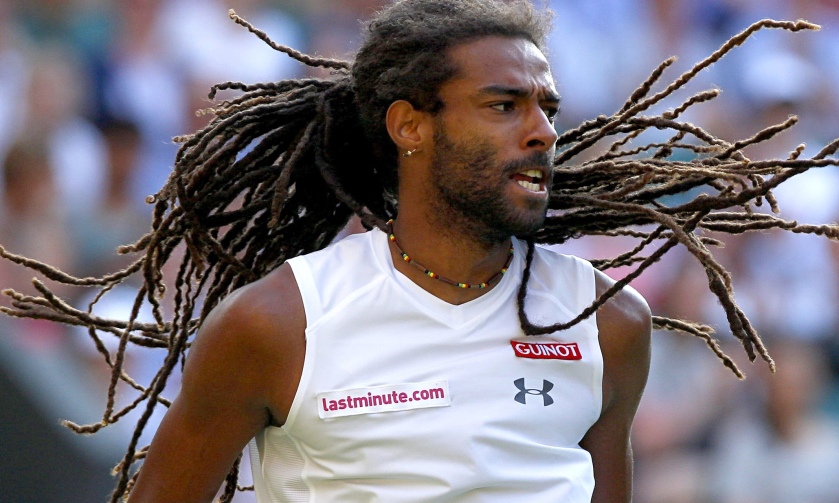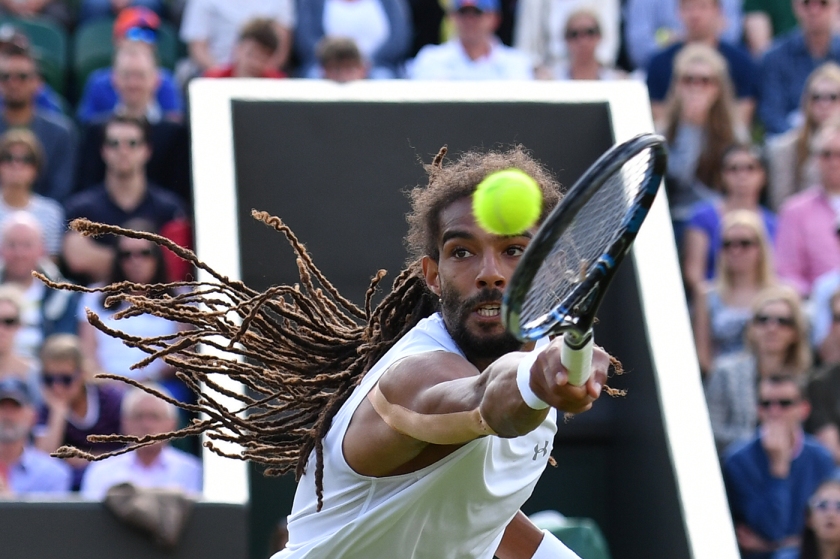Dustin Brown is probably one of the most peculiar tennis players of the present time. There follows a biographical sketch of this distinctive character of the ATP circuit
If the order and classification of the ATP rankings depended on levels of popularity and brand awareness, surely Dustin Brown would position himself in the first half of the top one hundred best players of the world. He draws attention in many ways in that shared lineage, half German –because of his mother- half Jamaican –father- that makes him, on the one hand, prefer the German nationality and residence to pursue the development of his sport career, and on the other hand, enjoys his jamaican bloodline as it is shown on his looks and on his tastes on music. His dreadlocks stand out on the ATP circuit always including him on the photo galleries of the tournaments like on the last Wimbledon championships in which he leads a photo selection showing the particular forms of the hairs of male and female players at the moment of impacting the ball. It is fair to say within this criterion that only Brown –and at the moment a junior unknown Stefanos Tsitsipas- participates on this pick: the rest are female players of the WTA.
His personal history is full of pecularities too. Having born and living in Germany until the age of 11, he migrated with his parents to Jamaica because of economic causes that included the costs of his tennis training. In Jamaica Dustin would keep on playing his favourite sport but the island didn’t have -among other things- neither good courts nor adequate facilities. Only when he was 20 he returned to Europe to undertake his professional career. The plan was like this: his parents would take a loan and buy him a Volkswagen camper van with three beds, a kitchen and a bathroom. This would let Dustin travel all around Europe from tournament to tournament at a low cost, saving on restaurants and hotel rooms. Moreover, like many other tennis players looking for extra incomes, Dustin would string rackets for others players in his free hours outside the courts.

It took Dustin and his family six years to cancel that loan and after that moment he could achieve his first important results on the circuit. In 2010 after a series of good results on challenger tournaments –second level tournaments if we take ATP tournaments as a whole- he positioned himself within the top first one hundred players: no. 99 of the ATP ranking. But it wasn’t until 2013 that Brown gained recognition from the major tennis audience by defeating the unbearable criyin’ baby of Lleyton Hewitt at Wimbledon’s second round. That day Brown started to attract the flashes and not only because of his appearance. Hewitt suffered the constant ‘serve & volley’ style that Dustin Brown applies almost as his unique strategy on the court without taking into notice that today the top players are characterized by a powerful serve and by directing their shots from the baseline, visiting the net in few ocassions as a consequence. He rehearses the most extraordinary parabolas with his racket so that, after being returned, he could fly and dive into the courts saving this way incredible points.
In 2015 Brown would perform a huge strike. As the man who made reggae music to be listened in the entire world suceeding in London, Dustin shone on Wimbledon again this time winning over that another tireless warrior called Rafael Nadal. Four sets in which Brown unfolded all his mastery in the execution of slices, jumping volleys and balls striken almost from the ground. He practised many fantastic points like the 0-30 receiving in the ninth game of the first set : a right-handed slice with an up and down direction, hitting the ball in a quick movement and charging it with an counter-effect making the ball get punctured the very moment it touched the ground and slipped away from Nadal. (Watch “Rafael Nadal vs Dustin Brown Highlights Wimbledon 2015“). These kind of plays produced by thousands by Brown are the ones that makes him be every week on the top ten’s of the most spectacular actions of the circuit.
Like any other professional activity, tennis avoids risk as a principle for developing itself. In that enviroment Brown plays, gifts show and challenges opponents making those to respond in a spectacular way too and reaching superlatives levels when he gets to return balls that are impossible for rivals. Irrational, naive for many people, those who enjoy this sport are grateful for having the possibility of watching something that is not just power and speed . It is not that we don’t admire those skills on the best players of the circuit… as a declaration of principles –and an evidence of the structural homology explained in previous posts following Pierre Bourdieu’s theory- in an official interview of the last Wimbledon Championships –the ‘If Series’- when the reporter asked Brown ‘if you could meet one other sport star’ Dustin answered doubtless ‘Dennis Rodman’.

